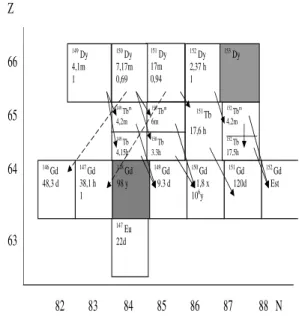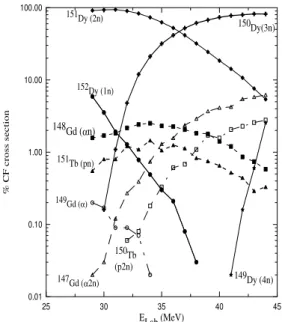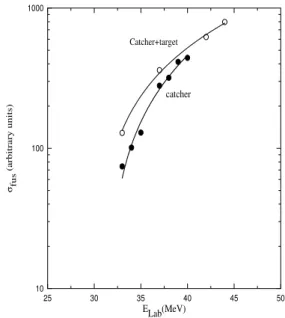902 Brazilian Journal of Physics, vol. 35, no. 3B, September, 2005
Complete Fusion of Weakly Bound Nuclei Applying the
Delayed X-Ray Technique: the
9
Be +
144
Sm System
P. R. S. Gomes1, I.Padron1,∗, O.A. Capurro2, J.O. Fern´andez Niello2, G.V. Mart´ı2, R. M. Anjos1, J. Lubian1, R. Veiga1, E. Crema3, A.J. Pacheco2, J.E. Testoni2, A. Arazi2, M.D. Rodr´ıguez2,4, M. E. Ortega2,4, and M. Trotta5
1Instituto de F´ısica, Universidade Federal Fluminense, Niter ´oi, R.J., 24210-340, Brazil 2Laboratorio Tandar, Departamento de F´ısica, Comisi´on Nacional de Energ´ıa At´omica,
Av. del Libertador 8250, (1429), Buenos Aires, Argentina
3Departamento de F´ısica Nuclear, Universidade de S˜ao Paulo,
Caixa Postal 66318, 05315-970, S˜ao Paulo, S.P., Brazil
4Departamento de F´ısica, FCEyN, UBA, Buenos Aires, Argentina and
5INFN Sezione di Napoli,I-80126, Napoli, Italy. ∗Permanent address: CEADEN, P.O. Box 6122, Havana, Cuba
Received on 17 December, 2004
The detection of delayed X-rays produced by the decay that follows electron capture in the residual nuclei has been used in the past for the determination of fusion cross sections of tightly bound nuclei. In this work we applied this technique to study the effect of the break-up of a weakly bound projectile, like in the case of the9Be +144Sm system. Preliminary results of the complete fusion in this system at near barrier energies are presented.
In recent years, the study of the fusion of weakly bound nu-clei and the influence of the break-up process on the complete fusion cross section is a subject of great interest in nuclear physics, particularly due to the availability of radioactive be-ams with very low bound energy thresholds. This research can also be done with stable weakly bound nuclei, like6Li,7Li and9Be, which have break-up threshold energies from 1.45 MeV to 2.65 MeV, much lower than the usual 8 – 10 MeV required to break-up a tightly bound nucleus.
The study of complete-fusion (CF) reactions using weakly bound projectiles generally presents great difficulties. This occurs because the corresponding evaporation residues are very similar to, or even coincident with, those coming from incomplete fusion (ICF) , i.e., reactions in which one of the break-up fragments of the projectile fuses with the target. Therefore, what is usually measured is the total fusion cross section, that is, the sum of CF and ICF cross sections instead of the individual contributions required to investigate the ef-fect of the break-up process on the CF cross section.
Separate measurements of CF and ICF cross sections for the
9Be,6,7Li +208Pb,209Bi systems were performed at Canberra and Legnaro[1–4] using the detection of decay alpha parti-cles. The residual nuclei of the fusion of these systems decay by alpha emission with life times compatible with typical ir-radiation and detection times. These experiments found that for these heavy targets, the ICF is responsible for suppression of the order of 25 – 30% of the CF cross section, at energies above the Coulomb barrier.
There are some experimental evidence[5, 6] that this CF suppression becomes negligible when light mass targets are used. One needs to perform experiments with different and lighter targets, if one wants to fully understand the process. However, the fusion residues of lighter systems do not decay by the emission of alpha particles.
As an alternative method, we propose the off-line detec-tion of the X-rays produced when the residual nuclei decay by electron capture with half-lives from some minutes to se-veral hours. This method was successfully applied by our
151 Tb 17,6 h 147 Gd 38,1 h 1 146 Gd 48,3 d 148 Gd 98 y 152 Gd Est 149 Gd 9.3 d 151 Gd 120d 150 Gd 1,8 x 106 y 147 Eu 22d 149 Tbm 4,2m 149 Tb 4,15h 150 Tbm 6m 150 Tb 3.3h 152 Tbm 4,2m 152 Tb 17,5h 153 Dy 152 Dy 2,37 h 1 151 Dy 17m 0,94 150 Dy 7,17m 0,69 149 Dy 4,1m 1 Z 66 65 64 63
82 83 84 85 86 87 88 N
FIG. 1: Decay characteristics of the complete fusion compound nu-cleus153Dy and the incomplete fusion compound nucleus148Gd.
groups[7–11] for the study of sub-barrier fusion of tightly bound nuclei.
We have searched for systems with6,7Li and9Be as projec-tiles and targets not too heavy that produce CF residual nuclei decaying by electron capture (EC) different from those present in the case of ICF. The primary selected target was144Sm.
The next step was to verify quantitatively the predictions of the evaporation code PACE [12] for the evaporation of the compound nucleus for each o these systems. The most suita-ble system was found to be9Be +144Sm, as it will be
explai-ned in the following.
P. R. S. Gomes et al. 903
25 30 35 40 45
ELab (MeV) 0.01
0.10 1.00 10.00 100.00
%
CF
c
ro
ss s
e
c
tion
150Dy(3n)
147Gd (α2n)
151Dy (2n)
149Gd (α)
149Dy (4n) 152Dy (1n)
151Tb (pn)
150Tb (p2n) 148Gd (αn)
FIG. 2: Predictions of the evaporation code PACE for the evaporation following the complete fusion of9Be +144Sm.
144Sm),153Dy and148Gd, respectively.
Figure 2 shows the predictions of the code PACE for the CF of the9Be +144Sm system, corresponding to the energy range from 0.8 VBto 1.4 VB, where VBis the height of the Coulomb
barrier.
The predictions of the code PACE for the ICF ofα+144Sm, assuming that the energy of theα particle is [4/9 E (9Be) – Sn], where Sn= 1.57 MeV is the break-up threshold energy
for the fragmentation of9Be in n + 2α,can be obtained. The code predicts that the two main evaporation channels produce the148Gd and147Gd nuclei at this energy range (near to the Coulomb barrier for theα +144Sm system). The first is al-most stable, whereas the second can be measured, although at high energies it may be slightly contaminated by one CF evaporation channel.
The experiment was performed at the Tandar Laboratory in Buenos Aires. A target of BeO was used to produce9Be be-ams, with energies from ELab= 29 MeV to 44 MeV, with a 1
MeV interval, ranging from sub-barrier to above barrier ener-gies. Five 88% enriched144Sm targets were used, with thick-nesses from 170 µg/cm2to 230 µg/cm2and carbon backings
of 20 µg/cm2.
An aluminum catcher foil was placed a few millimeters behind the target. The suitable catcher foil thickness of 1.6 mg/cm2was chosen in such way that it should stop the fusion
residues and leave the elastic scattering particles go through. During the irradiation of the target, the beam intensity was re-corded by multi-scaling in one-minute intervals. One surface barrier silicon detector - placed at 30 degrees with the beam direction - was used as monitor for normalization purposes. The typical irradiation time was 2 hours.
Due to the fact that a fraction of the fusion residues with the lowest energies were trapped in the target, after each
irra-diation we removed the target and the catcher foil and placed both of them in front of the a LEP (Low Energy Photon) de-tector. Since each target was used more than one time, the residual X-ray counting rate from the previous irradiation was accumulated, in order to subtract the background. Typically, five minutes passed between the end of an irradiation and the beginning of the X-ray accumulation spectra.
For the detection of the delayed K X-rays, a LEP germa-nium detector was used. The lines to be analyzed were the Kα1 and Kα2X-rays from Tb, Gd and Eu, with energies in
the range from 40.90 to 44.48 keV. The energy separation of the peaks was around 700 eV, and since energy resolution of the detector was∆EFW HM= 600 eV at the energy range of the
KαX-rays, it was possible to resolve the lines. Furthermore, since the relations between the Kα1 and Kα2X-rays of each
element are well known, they were used to check the con-sistency of the peak fit procedure. The peak shape was well determined by the Gd X-rays emitted by the standard152Eu
calibration source.
As we needed to discriminate between identical X-rays cor-responding to isotopes with different half-lives, an automatic set of counting runs was programmed. Due to the half-lives characteristics, the following set of counting periods for the delayed X-rays was used: 3 runs of 5 minutes, 3 runs of 15 minutes and 2 runs of 30 minutes each, corresponding to the total counting time of two hours. For some energies we have also accumulated long runs lasting several hours, in order to improve the statistics of the Eu X-rays corresponding to the T1
2 = 38.1 hours decay of
147Gd.
The energy calibration and LEP Ge (HP) detector efficiency were measured using the gamma-ray lines in the range of 30-300 keV of the following standard radioactive sources:152Eu, 133Ba,137Cs,241Am and57Co.
Figures 3a and 3b show typical KX-ray spectra. Both cor-respond to the bombarding energy of 40 MeV. The spectrum displayed in figure 3a was obtained from a short run taken a few minutes after the end of the irradiation, whereas the one shown in figure 3b was obtained from a long run taken 90 mi-nutes after the end of the irradiation. One can observe that the relative intensity of the Tb X rays associated with the first decay generation decreases with time, whereas the opposite happens for the Gd X-rays.
For the fusion cross section derivation, we used a code spe-cially written for this purpose, the XRWEPC[13], adapted from the original X-RAY code[14]. The main features of the code can be summarized as follows.
The fusion cross section is written as
σf usion=
∑
APA, (1)
where PAare the individual evaporation cross sections while
the peak area of the KαX-rays can be expressed as
NZ−1(tI,tF) =C
∑
AWZ,AFZ,A(tI,tF)PA, (2) being tIand tF the initial and final counting time of the run,
904 Brazilian Journal of Physics, vol. 35, no. 3B, September, 2005
FIG. 3: Typical KαX-ray energy spectra, at laboratory bombarding energy of 40 MeV. The spectrum on the upper part of the figure was obtained from a short run taken a few minutes after the end of the ir-radiation, whereas the spectrum on the lower part was obtained from a longer run taken 90 minutes after the end of the irradiation.
scattering and the X-ray detector efficiency, WZ,Ais the num-ber of KαX-rays produced for each nucleus (Z,A) decay, FZ,A (tI, tF) is the number of decays of the nucleus (Z,A) per
uni-tary production of the residues of mass A, which is a function of the time depending on the beam intensity in the irradiation time interval (tI, tF) and on the half-lives of the residual
nu-clei. The coefficients W(Z,A) were taken from[15].
The PA values are obtained from simultaneous fits of all
points of the yields of KαX-rays as a function of time. This procedure allows to check the self consistency, because within one chain corresponding to one value of A there is more than one decay generation.
Figure 4 shows a typical simultaneous fit of the three diffe-rent X-ray counting rates, as a function of time. One can ob-serve how the time dependence of the X-rays emitted by each element can be decomposed into the corresponding decay of each isotope, with different half-lives.
The fusion data analysis is under way and the cross section values and the interpretation of these reaction mechanisms will be reported in the near future. Within the aims of this paper, we show in figure 5 some preliminary results for the fusion cross section, at some energies, corresponding to the accumulation of X-rays emitted just from the aluminum cat-cher foil itself and from the set catcat-cher foil + target.
In summary, this work presents an alternative method for the measurement of complete fusion of weakly bound nuclei based on the delayed X-rays technique. This method allows us to distinguish between complete and incomplete fusion if an appropriate system is chosen; that is, systems in which each evaporation residue is fed by only one of the fusion processes. This is the case of the9Be +144Sm leading to the compound
120 160 200 240
Time (min) 10
100
Co
un
ts /
mi
n
Z = 65
Z = 64
Z = 63
FIG. 4: Typical simultaneous fit of KαX-rays emitted by three dif-ferent elements, and several isotopes.
25 30 35 40 45 50
ELab(MeV) 10
100 1000
σfu
s
(arb
itra
ry
un
its
)
Catcher+target
catcher
FIG. 5: Preliminary results of the fusion cross section, showing the importance of the measurement of X-rays emitted by both catcher foil and target. When only the catcher foil was placed in front of the detector, only a fraction of the cross section was derived.
nucleus153Dy, for which the evaporation residues are different from the residues of the incomplete fusion.
Acknowledgments
P. R. S. Gomes et al. 905
[1] C. Signorini et al., Eur. Phys. J. A 2, 227 (1998). [2] M. Dasgupta et al., Phys. Rev. Lett. 82, 1395 (1999). [3] M. Dasgupta et al., Phys. Rev. C 66, 041602R (2002). [4] M. Dasgupta et al., Phys. Rev. C 70, 024606 (2004). [5] S.B. Moraes et al., Phys. Rev. C 61, 64608 (2000). [6] P.R.S. Gomes et al., Heavy Ion Physics 11, 361 (2000). [7] D. di Gregorio et al., Phys. Lett. B 176, 322 (1986). [8] D. di Gregorio et al., Phys. Rev. C 39, 516 (1989). [9] S. Gil et al., Phys. Rev. Lett. 65, 3100 (1990).
[10] P.R.S. Gomes et al., Phys. Rev. C 49, 245 (1994). [11] M. di Tada et al., Phys. Rev. C 47, 2970 (1993). [12] A. Gavron, Phys. Rev. C 21, 230 (1980). [13] O.A. Capurro, Private communication.
[14] A.J. Pacheco et al., Comp. Phys. Communications 52, 93 (1988).


